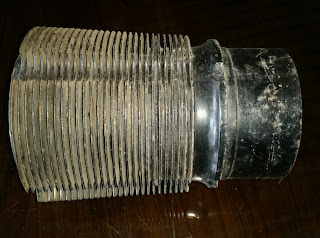Piston
Piston is a cylindrical member which moves back and forth within a steel cylinder. The piston acts as a moving wall within the combustion chamber.
As the piston moves down in the cylinder, it draws in the fuel/air mixture. As it moves upward, it compresses the charge, ignition occurs, and the expanding gases force the piston downward. This force is transmitted to the crankshaft through the connecting rod. On the return upward stroke, the piston forces the exhaust gases from the cylinder and the cycle repeats.
Pistons are machined from aluminum alloy forgings. Grooves are machined in the outside surface of the piston to receive the piston rings, and cooling fins are provided on the inside of the piston for greater heat transfer to the engine oil.
Pistons may be either the trunk type or the slipper type.
Top of the piston, or head, may be flat, convex, or concave. Recesses may be machined
in the piston head to prevent interference with the valves.
Modern engines use cam ground pistons that are a larger diameter perpendicular to the piston pin. This larger diameter keeps the piston straight in the cylinder as the engine warms up from initial start up.
As many as six grooves may be machined around the piston to accommodate the compression rings and oil rings.
Compression rings are installed in the three uppermost grooves; the oil control rings are installed immediately above the piston pin.
Piston is usually drilled at the oil control ring grooves to allow surplus oil scraped from the cylinder walls by the oil control rings to pass back into the crankcase.
oil scraper ring is installed at the base of the piston wall or skirt to prevent excessive oil
consumption.
The portions of the piston walls that lie between ring grooves are called the ring lands.
In addition to acting as a guide for the piston head, the piston skirt incorporates the piston-pin bosses. The piston-pin bosses are of heavyconstruction to enable the heavy load on the piston head to be transferred to the piston pin
As the piston moves down in the cylinder, it draws in the fuel/air mixture. As it moves upward, it compresses the charge, ignition occurs, and the expanding gases force the piston downward. This force is transmitted to the crankshaft through the connecting rod. On the return upward stroke, the piston forces the exhaust gases from the cylinder and the cycle repeats.
Pistons are machined from aluminum alloy forgings. Grooves are machined in the outside surface of the piston to receive the piston rings, and cooling fins are provided on the inside of the piston for greater heat transfer to the engine oil.
Pistons may be either the trunk type or the slipper type.
Top of the piston, or head, may be flat, convex, or concave. Recesses may be machined
in the piston head to prevent interference with the valves.
Modern engines use cam ground pistons that are a larger diameter perpendicular to the piston pin. This larger diameter keeps the piston straight in the cylinder as the engine warms up from initial start up.
As many as six grooves may be machined around the piston to accommodate the compression rings and oil rings.
Compression rings are installed in the three uppermost grooves; the oil control rings are installed immediately above the piston pin.
Piston is usually drilled at the oil control ring grooves to allow surplus oil scraped from the cylinder walls by the oil control rings to pass back into the crankcase.
oil scraper ring is installed at the base of the piston wall or skirt to prevent excessive oil
consumption.
The portions of the piston walls that lie between ring grooves are called the ring lands.
In addition to acting as a guide for the piston head, the piston skirt incorporates the piston-pin bosses. The piston-pin bosses are of heavyconstruction to enable the heavy load on the piston head to be transferred to the piston pin



Comments
Post a Comment